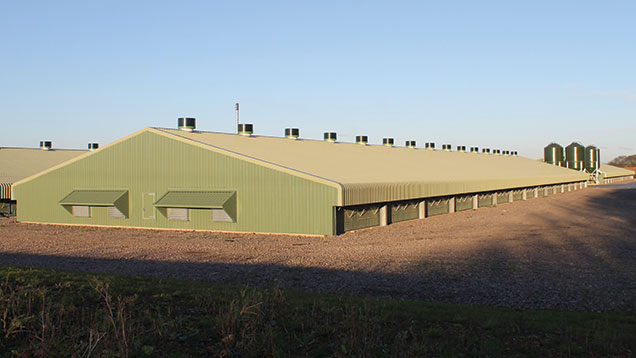Good investor prospects to be found in poultry

The UK poultry property market is on a rising plain, according to consultancy firm Bidwells, and could represent an opportunity for investors from outside the sector.
In its latest Food and Drink report, the firm estimates that the broiler property market extends to approximately 69-73m sq ft – equivalent to around 960 football pitches – and has increased by 20-25% since 2010.
“Over the past three years, Bidwells has valued just over 450 poultry farms in the UK, worth just over £575m, covering 52m sq ft,” says head of food and drink at the firm, Ian Peck. That equates to an average capital value of about £11/sq ft.
“It is clear that the poultry sector is a surprisingly large and dynamic component of the UK property market. It is extensive in scale and rising rapidly in value as the sector expands and increasingly high-quality property is developed and utilised.”
See also: Farmers Weekly Property For Sale
As such, he sees it as a viable investment proposition – both in the broiler sector and the free-range egg sector – and has been advising several arable farmers of late about coming into the industry.
“Margins may be tight but, as in any sector of farming, given the right buildings and equipment, together with good management, then there is money to be made,” he says.
Adding a poultry unit to any farming enterprise also helps diversify the income stream – and earnings are likely to be less volatile than in some other areas. “A poultry enterprise can also be good for succession planning, providing an opportunity for the next generation coming into farming.”
Expansion
The report points to the continuing growth of the poultry market and, as such, demand for housing stock.
“Poultry placings are nearly 30% higher now than 10 years ago, with annual production heading towards one billion birds a year,” it says.
“According to Defra, per capita poultry consumption rose from 21kg to 33kg over the period 1990-2013. We consume more poultry than any other meat, with current consumption rates a third higher than pork and more than six times higher than lamb.
“The rise of white meat over red meat in the consumer diet looks set to continue unabated as a comparatively cheap source of reduced fat protein. As demand for poultry produce continues to rise, so too will the poultry property market.”
This demand for housing stock could be exacerbated by the possible reduction or end to crop thinning, as the sector tries to get on top of campylobacter. “This could lead to a 10-15% increase in floor space in order to accommodate variations in stocking density. Anti-campylobacter measures may therefore stimulate demand for more property accommodation.”
Green revenue
Mr Peck also points to opportunities to add renewable energy to the property portfolio.
“Many poultry farms are now developing renewable energy technologies including biomass boilers, solar panels, wind turbines and ground source heat pumps. This improves eco-credentials, promotes production efficiency and adds additional revenue.
“Ancillary buildings on poultry farms are also being improved to raise productivity, reduce infection and enhance image. Importantly on-site farm manager dwellings are being upgraded in order to attract and retain high-quality stock management and expertise.”
Overall, the report says the poultry property market is buoyant.
“Rising accommodation standards and enhanced building specifications will cause both rents and capital values to increase in the years ahead,” it says. “Whilst this will cause an uplift in farming overheads, better buildings will also lead to increased productivity, better for the welfare of the birds and more robust operating margins.”
Two-tier market
According to the study, the poultry property sector is increasingly a two-tier market with modern, high-spec buildings contrasting with older, less efficient stock in need of either upgrade or replacement.
“The UK poultry property market is undergoing a transformation. Despite rapid redevelopment and upgrades in recent years, it still faces a substantial refurbishment in order to access production efficiency gains, better conform to regulations and provide consumers with improved pre-sale provenance.”
